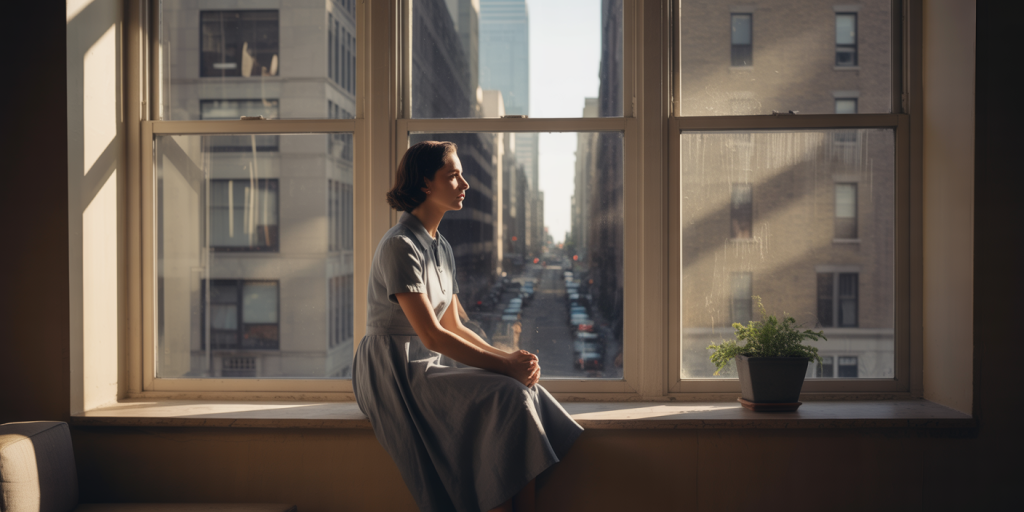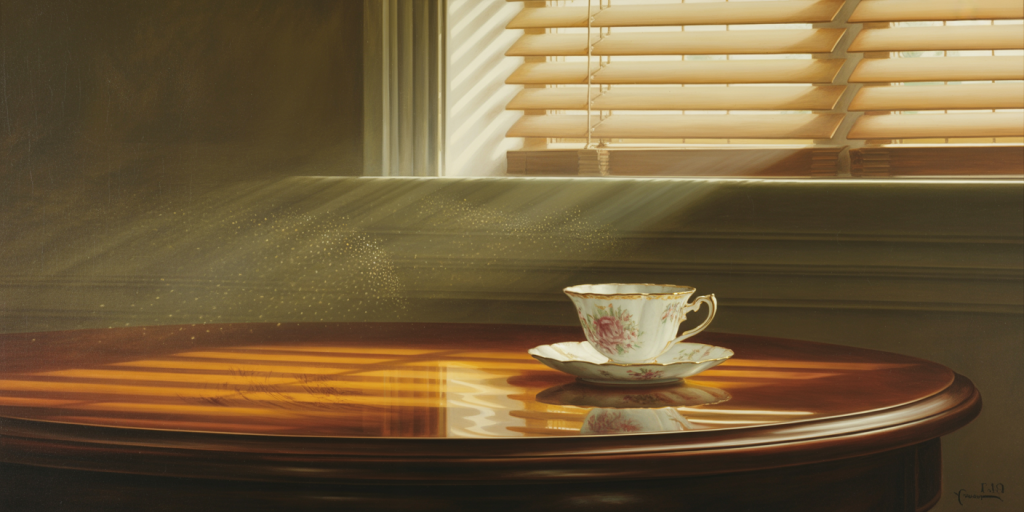Edward Hopper’s Windows and the Silences of Urban Solitude
Opening Meditation
There are windows that look out—and others that look inward. Edward Hopper’s are both. They hang like mirrors suspended in brick, panes of silence that do not reflect, but remember. In the hush between buildings and thought, between the distant hum of traffic and the crack in a curtain, Hopper’s windows pulse quietly, not with life, but with its echo. They are the openings through which solitude breathes.
Urban solitude is not mere absence—it is presence misunderstood. In Hopper’s canvases, solitude is a room filled with late light, a diner cornered by night, a woman paused in thought beside a window that knows her secrets. His windows do not open to views. They open to moods: pensive, suspended, unfinished. They do not show the world. They show its aftermath.

Table of Contents
- The Threshold of Light
- Figures Framed, Not-Seen
- Glass as Emotional Filter
- The Geometry of Separation
- Stillness Hung in Midair
- Interiors that Speak in Hushed Tones
- The Color of Withheld Affection
- When Silence Occupies the Room
- Shadows that Linger Longer
- The Distance Between People and Walls
- Urban Rooms Like Aquariums
- A Window Is a Question
- The Tactile Edge of Loneliness
- Rooms with One Direction
- Openings That Do Not Invite
- Still Figures in Fluid Time
- Curtain, Frame, and Gaze
- Isolation Framed by Habit
- Where the Gaze Never Meets
- A City Whispered Through Glass
The Threshold of Light
In Hopper’s paintings, the window is a luminous knife. It slices darkness with still light—light that neither moves nor warms, but reveals. These thresholds of illumination are not natural transitions; they are metaphysical pauses.
The light through these windows doesn’t spill. It rests. It stains the floor with quiet insistence, flattening time into moment. Through them, Hopper says: this is not about what is seen, but about what is waiting to be seen.
📍 [Insert general artwork image here]
Figures Framed, Not Seen
Hopper’s figures are often positioned near windows, but never fully within them. They are edged by light, captured in posture. Their emotions are not performed, but restrained. This framing suggests not surveillance, but reverie.
We are invited to witness, not interact. The window becomes a threshold of empathy—always near, never entered. The composition encourages a sense of respect for solitude, rather than invasion of privacy.
Glass as Emotional Filter
Glass in Hopper’s world is not transparent. It distorts gently. The viewer sees through it but also feels the resistance. It is a veil of melancholy, a quiet scrim that blurs contact.
His brushwork treats glass not as clarity, but as threshold. The reflections are subtle, often invisible. But the feeling is present: we are separated not by distance, but by experience. Glass becomes the material of disconnection.
The Geometry of Separation
Hopper’s architectural structures rely on clean lines and subtle angles. The windows are never randomly placed. They are portals arranged with surgical precision, often dividing rather than connecting.
The grid-like quality of urban design becomes symbolic: isolation is not chaos—it is ordered, structured, lived-in. Each wall is both shelter and border. Each window, a silent proposition.
Stillness Hung in Midair
There is a suspended quality to Hopper’s compositions. The figures seem caught between inhale and exhale. The window, in this case, becomes a witness—not to action, but to inaction.
This stillness is active. It holds tension, quiet desire, unspoken fear. Even a half-drawn blind or a slant of shadow becomes a gesture. Hopper captures the drama of hesitation.
📍 [Insert symbolic detail image here]
Interiors that Speak in Hushed Tones
Hopper’s interiors are often sparse—almost theatrical in their minimalism. Yet within these bare rooms lies a symphony of emotional suggestion. A window set high, a wall left bare, a chair turned away from the light: each is a murmur.
The color palette reinforces this mood: ochres, pale greens, soft grays. These are not dramatic hues. They are the colors of lived silence, of restrained emotion, of endurance.
The Color of Withheld Affection
Emotion in Hopper’s windows is not declared—it is withheld. His tones suggest longing, but never fulfillment. The warmth of a sunrise is filtered through cold panes. The light never reaches the subject fully.
This palette—muted, indirect—echoes the internal state of his characters. There is feeling, but it is folded inward, like a letter never mailed. The window becomes a symbol of emotional distance.

When Silence Occupies the Room
The most persistent character in Hopper’s work is not a person—it is silence. And nowhere is silence more alive than in the presence of a window. It rests on the bedspread, leans against the walls, pauses in the figure’s posture.
This silence is not emptiness. It is saturated. A kind of slow echo that fills the air between subject and viewer. It creates the atmosphere of the painting, more than any object ever could.
Shadows that Linger Longer
Hopper’s shadows are deliberate, sculptural. They move across windows, cut diagonals into rooms, frame bodies with an almost theatrical chiaroscuro. But they never disappear.
These shadows last longer than expected. They stay behind after the moment has passed. They hold memory. They are the visible remains of something no longer present.
The Distance Between People and Walls
Sometimes, Hopper paints more than one figure—but never intimacy. Even in shared spaces, the characters seem to orbit different moons. The window, placed between or beside them, accentuates this disconnect.
There is no bridge. No hand reaching. Just space. And this space is the most eloquent subject of the scene. It is the emotional architecture of loneliness.
Urban Rooms Like Aquariums
Many of Hopper’s interiors feel exposed—like boxes with glass sides. The window is no longer a private opening; it becomes a display case. The subject, lit and framed, is an exhibit of isolation.
This voyeuristic composition asks: are we viewers or accomplices? The figure behind the glass does not react. They are resigned to being seen. The city watches them. They look elsewhere.
A Window Is a Question
What lies beyond? This is the window’s eternal inquiry. Hopper never answers. His windows offer no narrative—only contemplation. They are invitations not to leave, but to pause.
Each frame within a frame opens to a speculation. They are philosophical more than pictorial. They make space for the viewer’s own reflection, both literal and emotional.
The Tactile Edge of Loneliness
You can almost touch Hopper’s solitude. It is textured—like the grain of painted wood, or the smooth edge of glass cooled by night. His technique emphasizes this physical quietude.
With deliberate brushstrokes, he outlines edges, defines planes. This tangibility heightens the emotional effect. Loneliness is not abstract. It has mass. It sits with weight in a chair by the window.
Rooms with One Direction
Perspective in Hopper’s rooms is rarely neutral. The window dictates orientation. The figure is drawn toward it—gazing out, leaning in, even ignoring it deliberately. The entire composition follows that silent command.
This directional pull is rarely rewarded. The view beyond is obscured, washed out, empty. The tension lies in the impulse itself—the ache to see something more.
Openings That Do Not Invite
Despite being architectural apertures, Hopper’s windows do not suggest entry. They are not doors. They are not open arms. They are thresholds that resist.
Even when the glass is clear, there is an emotional fog. Even when open, they let in only silence. They are invitations to introspection, not connection.
📍 [Insert modern aesthetic reinterpretation image here]
Still Figures in Fluid Time
Time in Hopper’s windows does not pass. It holds. His figures do not age. They do not rise. They remain—like thoughts caught in the moment before decision.
The light may shift, but the mood does not. These are scenes that suspend chronology. Each becomes a study in the persistence of emotion.
Curtain, Frame, and Gaze
The trinity of Hopper’s window scenes often includes curtain, frame, and gaze. The curtain half-drawn, the frame cleanly rendered, the gaze ambiguous. This trio forms a symbolic vocabulary.
The curtain reveals and withholds. The frame contains and isolates. The gaze questions without answering. Together, they construct the poetics of quiet withdrawal.
Isolation Framed by Habit
These are not exotic moments. They are habitual. A woman reading, a man shaving, a couple dressed for nothing in particular. The window gives these mundane acts the gravity of ritual.
Hopper does not dramatize. He observes. And through this careful framing, even ordinary solitude becomes elevated—worthy of oil and canvas, worthy of attention.
Where the Gaze Never Meets
Even when figures share a room, their eyes do not find each other. Their windows are personal. They each look out from their own aperture, unaware of parallel yearning.
This lack of connection becomes symbolic. The window becomes both a shared environment and an isolating mechanism. It is not just glass—it is the idea that everyone looks, but few truly see.
A City Whispered Through Glass
The city in Hopper’s world does not shout. It whispers. It murmurs in steam, in late afternoon sun, in blinds drawn halfway. It is not skyline—it is sidewalk.
His windows capture this intimacy. They do not show grandeur. They show the human scale of melancholy. The rhythm of breathing in a room just after someone has left.
FAQ – Questions and Answers
Who was Edward Hopper?
An American realist painter (1882–1967), Hopper is best known for his depictions of modern urban life marked by quiet isolation, stark lighting, and psychological nuance.
Why are windows so central in his work?
Windows in Hopper’s paintings symbolize thresholds between public and private, exterior and interior, connection and solitude. They frame both physical and emotional space.
What painting techniques define his style?
Hopper used clean lines, layered oil paint, and careful lighting to craft atmosphere. His controlled palette and precise compositions evoke strong emotional resonance.
Are his paintings based on real places?
Often inspired by actual locations, Hopper’s scenes are distilled composites. He simplified and restructured reality to serve mood over realism.
What emotional tone defines his work?
Melancholy, introspection, quiet tension, and restrained longing—Hopper’s paintings are meditations on human presence amid social and spatial alienation.
Final Glance Through the Pane
Edward Hopper’s windows do not open to the city. They open to ourselves. In each frame of light, in each silent figure, we see our own reflection—not of form, but of feeling. His windows frame not only solitude but the beauty of endurance within it.
Urban life, for Hopper, is not bustle—it is breath held in a still room. A light that refuses to leave. A thought that lingers just past words. And somewhere beyond that windowpane, the world waits—mute, unchanged, glowing softly like a withheld answer.

